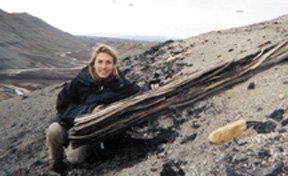Scientist’s Notebook: Working in the Arctic
 |
| Hope Jahren with a tree fossil on Axel Heiberg Island. |
| Photo by William Hagopian/JHU |
Axel Heiberg Island is far, far away from the United States. It has no movie theaters, no restaurants, no supermarkets or other stores, no TVs, and no people—except the researchers who come to dig in the dirt.
Simply getting to this Arctic island requires multiple flights on a series of smaller and smaller aircraft, says Johns Hopkins geobiologist Hope Jahren. “At the end of several days of this, a helicopter lands and puts you down on the island,” she says.
“You watch it fly away and you . . . wonder if the people around you are going to be okay,” Jahren says. “Somehow, it all works out.”
For three summers in a row, Jahren spent several weeks on the isolated spit of land in northern Canada with a group of students and colleagues. Each time, the team brought tents, radios, scientific equipment, medical supplies, and enough food to last for weeks.
The region is so far north that, during the summer months, darkness never arrives. “I tell the students beforehand not to bring a flashlight,” Jahren says. But “somebody always does.”
Without the sun’s cycle to set a schedule, the researchers tend to eat when they’re hungry, work until they get tired, and sleep until they wake up. Most people end up on a 27- or 28-hour cycle, Jahren says.
“You stop watching your watch after a while,” she says, “because it doesn’t really matter.”
Even in the summer, days are usually cold. Temperatures rarely rise above freezing. Every once in a while, Jahren says, the sun comes out, the mercury hits 45 degrees F, and everyone puts on shorts to soak in the relative warmth before the cold settles back in.
Digging for tree fossils in the Arctic is hard work because the ground is frozen. The scientists have to scrape away a 1-inch-deep section of soil, and then wait for the sun to warm the ground again before scraping away another inch-deep section.
Occasional wildlife sightings spice things up. One of Jahren’s favorites is the Arctic hare, which stands on its hind legs to look around and then runs on two feet. Upright, the furry, white animal can be 3 feet tall.
“Sometimes, if we’re digging and we see a rabbit,” Jahren says, “we’ll just put our stuff down and start following it for a couple hours.”
Other animal residents include musk oxen, Arctic ducks, and aggressive mosquitoes. Plant life includes Arctic cotton, Arctic willow, and some beautiful wildflowers. Colorful lichen covers the rocks.
Despite the cold weather and mosquito bites, Jahren says, Axel Heiberg is a pleasant place to spend a few weeks. The landscape is barren, icy, and breathtaking. You can see for miles and miles. The fossils are spectacular. And without the distractions of normal life, the quiet can be relaxing.
For now, however, Jahren has no plans to go back to Axel Heiberg. After 3 summers of digging there, she has enough material to fuel as many as 20 years’ worth of research.
“We have no need to go back and disturb the site,” she says. “We need to worry about it lasting another 45 million years.”—Emily Sohn